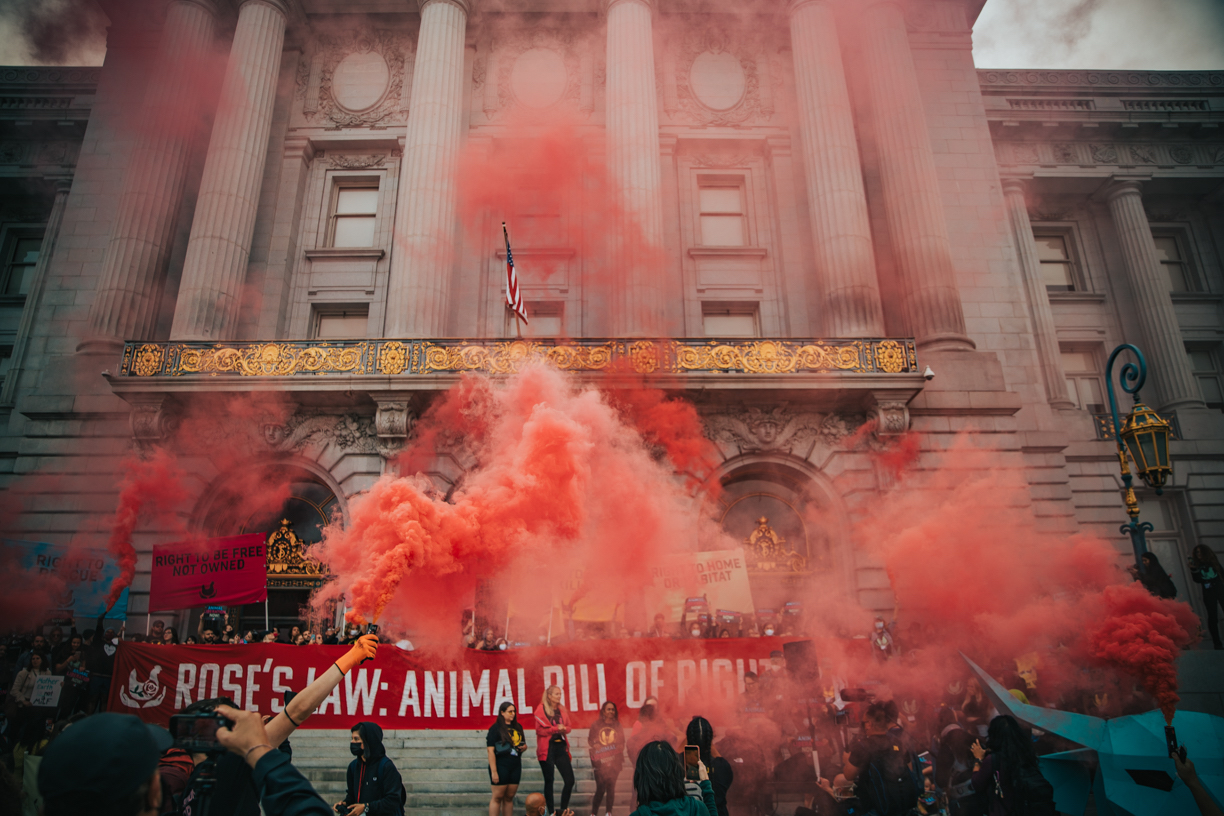Can We Break Dunbar’s Number?

We’ve been hovering around this 150 number for a while now in the SF Bay Area chapter, and we know we have to grow past this, so we set off to figure out how to break Dunbar’s number.
We’re building a mass movement to change the world for animals. Or are we? We know we need thousands upon thousands of activists hitting the streets for an animal bill of rights - history shows us this is almost certainly necessary to achieve our goals - but what do our numbers look like these days? The truth is, they don’t look great.
Certainly, part of this is the COVID-19 pandemic. In reality, though, the DxE SF Bay Area chapter’s growth had slowed well before the pandemic hit. While we’re still growing, we’re not growing as fast as we used to, and we’re not growing as fast as we need to. (1)
One plausible explanation for our slowed growth is that we’re hitting the limits of Dunbar’s number. (2) The basic concept of Dunbar’s number is that humans cannot sustain more than 150 or so social relationships, of which these 150 are further broken down by degrees of intimacy.
Generally, humans can have up to 5 extremely close friends (your support network), 15 very good friends, 50 friends, and 150 casual friends. (3) Even the most outgoing amongst us are limited by time since close friendships take time to build and maintain. And these numbers represent all our relationships, not just those within the animal rights community. Beyond 150, social connection and cohesion start to break down and we lose a sense of community and collective purpose - all key for social movements.
We’ve been hovering around this 150 number for a while now in the SF Bay Area chapter, and we know we have to grow past this, so we set off to figure out how to break Dunbar’s number. We reached out to Dr. Dunbar himself and he graciously took the time to answer our questions. Additionally, we spoke to Dr. Roger Bretherton, a psychologist who studied Dr. Dunbar’s work in relation to church growth (4), to see how we might apply it to our community organizing.
Not too surprisingly, Dr. Dunbar told us there’s nothing we can really do to “break” the limit. These constraints are based on biology and short of changing our brain size and structure, we’ll likely always be limited to ~150 meaningful relationships. Dr. Bretherton’s research showing that single-leader church congregations are often limited to 150 members supports this point. Furthermore, his research showed that as groups grow in size, the engagement of each group member decreases. When churches got big, the average churchgoer participated (and felt the need to participate) less. So even if we could grow much larger as one big unit, it might not be effective.
It also becomes harder for new people to join as groups become larger and more cohesive. We’ve all likely had the experience of joining a new community only to sense that the current members already had their “cliques.” And while the bullying or hostility that can come with cliquey-ness is something we never want in our communities, Dr. Dunbar’s research shows that “cliques” are likely just part of human social interactions. But how then do new people join? And how can we keep participation and engagement high?
The simple answer is that we “break up” and subdivide our community.
DxE is to some degree decentralized, and with large, decentralized organizations you actually need more structure. One very rigid way of doing this would be to cap the chapter when we reached ~150 members and seed a new one to bring in new members until that one hit ~150, and so on and so forth. The company Gore-Tex follows this almost to a tee - as soon as one factory hits 150 employees, they build a new one. (5) I’m not directly advocating that, since DxE has state- and city-wide goals that certainly benefit from having large groups of people working together towards a common goal. But I do think we need some subdivision.
Our first attempt at this was the circles program, in which people got together in small interest or identity-based groups on a regular basis. There are still many circles operating within the chapter, from the Asian Empowerment Circle to the Social Movement Book Club, and they have provided community, connection, and support for many members. However, the majority of our membership is not active in a circle. The weekly or biweekly meeting was a big commitment, travel across the Bay Area was difficult, and most new people were not joining circles.
Based on the first attempt with circles, the research and advice from Dr. Dunbar and Dr. Bretherton, and some pragmatic real-world organizing experience, we’re trying again. This is about the furthest thing from rocket science (and I take no credit for the original idea), (6) but we’re launching a circles program based strictly on geography. Our membership is being subdivided into groups of 5-15 based on who lives close to them, with a host for each. When new members join, they’ll automatically be added into a circle with other members in their immediate vicinity. Now, as a new activist, you’re not thrown into a pool of 150+ people, you’re thrown into one with 5-15. It’s not an added extra commitment, it’s part of the organizing structure.
The geographic radius in some areas, like Berkeley, will be small. There are 5 geographic circles in Berkeley alone. In others, a geographic circle will encompass multiple cities. And when circles start pushing past 15 people because new people have joined, they’ll split by geography again. (A note about splitting: No one likes to split, but research indicates that it’s crucial for long term growth that small groups continue to get split up as they grow. This fights entrenchment and stagnation and prevents the “decreased productivity” effect mentioned earlier.) (7)
These “geocircles” won’t have any strict regular meeting requirements, but it’s our hope and vision that they will naturally organize and participate in events together. Maybe a park clean-up or community service event in their city, lobbying their elected officials to support animal-friendly legislation, carpooling to an action together (post-COVID), etc… They’ll function as homerooms do in high school. You still go to your other classes outside of homeroom and you hang out with whomever at lunch, but you have homeroom to come back to - a means to disseminate key information and make sure no one falls through the cracks. It’s your place in the big school. And maybe your top 5-15 friends aren’t in your homeroom, but it’s likely that at least some people in your 150 will be. And at the risk of getting too ahead of ourselves, an extra layer of structure can eventually be introduced, whereby 3-5 geocircles come together to form a region, several regions come together, and so on and so forth.
Is this going to completely solve our growth problem and magically help us grow to the tens of thousands of activists we need? No. Our growth is likely also hindered by the fact that virtual connections, which we’re more dependent upon during the pandemic, do not seem to form the same bonds as in-person connections; the limitations of our physical space (the 1080 sqft Berkeley Animal Rights Center); capitalism and the cost of living in the Bay Area which prevents most people from having much free time to devote to activism; and the reality that the animal rights movement is still seen as a fringe issue by many. But having all members be part of a small group in addition to the broader chapter should help to build connections and a scalable structure that could theoretically support millions of activists. It is my hope that these circles will help ensure that all current and new members feel that they are an active part of this chapter once membership has grown to the point where they no longer recognize everyone.
I do think we can create a structure that supports the seemingly dichotomous ideas that personal connections are the key to growing our movement and that our movement needs to be so big there is no way anyone could know everyone involved. Building and supporting a community of activists is by far the hardest thing I have ever tried to do in my life, but there is no question in my mind that it’s worth it.
Footnotes:
(1) An important note: I don’t think this is that horribly devastating. I do not believe we are going to grow along a linear trajectory until we reach the critical mass needed to achieve change; more likely, we’ll continue with relatively small numbers until we experience a trigger moment that causes our movement to exponentially take off. Additionally, while our numbers haven’t grown substantially, our power has. Just in the last year, we’ve seen politicians lobby for new ag-gag laws because of our work, had charges dropped because corporate executives were terrified of taking the stand, pressured Iowa Select Farms to end their use of “ventilation shutdown,” and received unanimous support for our rescue efforts from the San Francisco Board of Supervisors.
(2) https://www.youtube.com/watch?v=07IpED729k8&ab_channel=TEDxTalks
(3) Here’s a great summary of the research in a fun 13-minute YouTube video: https://www.youtube.com/watch?v=O2qjRG6iV8M&ab_channel=Vsauce2
(4) https://journals.sagepub.com/doi/full/10.1177/0084672420906215
(5) https://www.npr.org/2011/06/04/136723316/dont-believe-facebook-you-only-have-150-friends
(6) Various organizations and activists have been exploring this idea or one very similar to it for many years, including Movimiento Cosecha, which was our first introduction to the idea of “circles.”
(7) Research also indicates that ensuring everyone understands why splitting is important and validating feelings of stress and discomfort during the process is helpful to a successful split.
Other articles

Tulare County Dairy Farms Are Poisoning Latino Communities

The Case for Systemic Change




